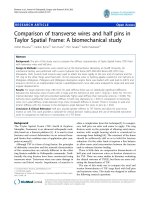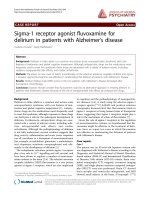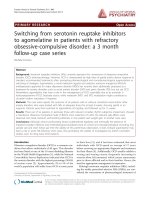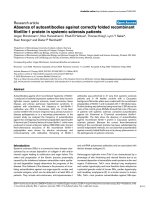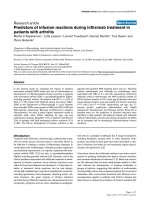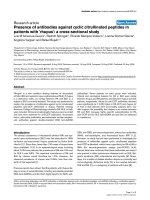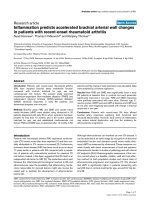Báo cáo y học: "Presence of antibodies against cyclic citrullinated peptides in patients with ''''rhupus'''': a cross-sectional study" pdf
Bạn đang xem bản rút gọn của tài liệu. Xem và tải ngay bản đầy đủ của tài liệu tại đây (127.22 KB, 5 trang )
Open Access
Available online />Page 1 of 5
(page number not for citation purposes)
Vol 8 No 5
Research article
Presence of antibodies against cyclic citrullinated peptides in
patients with 'rhupus': a cross-sectional study
Luis M Amezcua-Guerra
1
, Rashidi Springall
1
, Ricardo Marquez-Velasco
1
, Lorena Gómez-García
1
,
Angélica Vargas
2
and Rafael Bojalil
1,3
1
Department of Immunology, Instituto Nacional de Cardiología Ignacio Chávez, Juan Badiano 1, Sección XVI, Tlalpan 14080, Mexico City, Mexico
2
Department of Rheumatology, Instituto Nacional de Cardiología Ignacio Chávez, Juan Badiano 1, Sección XVI, Tlalpan 14080, Mexico City, Mexico
3
Department of Health Care, Universidad Autónoma Metropolitana Xochimilco, Calzada del Hueso 1100, Villa Quietud, Coyoacán 04960, Mexico
City, Mexico
Corresponding author: Rafael Bojalil,
Received: 14 Jul 2006 Revisions requested: 9 Aug 2006 Revisions received: 15 Aug 2006 Accepted: 25 Aug 2006 Published: 25 Aug 2006
Arthritis Research & Therapy 2006, 8:R144 (doi:10.1186/ar2036)
This article is online at: />© 2006 Amezcua-Guerra et al.; licensee BioMed Central Ltd.
This is an open access article distributed under the terms of the Creative Commons Attribution License ( />),
which permits unrestricted use, distribution, and reproduction in any medium, provided the original work is properly cited.
Abstract
'Rhupus' is a rare condition sharing features of rheumatoid
arthritis (RA) and systemic lupus erythematosus (SLE). If rhupus
is a distinctive entity, an overlap between RA and SLE or a
subset of SLE is currently debated. This study was performed to
explore the prevalence of antibodies against cyclic citrullinated
peptides (anti-CCP antibodies) in rhupus. Patients meeting
American College of Rheumatology criteria for RA, SLE, or both
were included. Clinical and radiographic features were recorded
and sera were searched for anti-CCP antibodies, rheumatoid
factor, antinuclear antibodies, anti-extractable nuclear antigens,
and antibodies against double-stranded DNA (anti-dsDNA
antibodies). Seven patients for each group were included.
Clinical and serological features for RA or SLE were similar
between rhupus and RA patients, and between rhupus and SLE
patients, respectively. Values for anti-CCP antibodies obtained
were significantly (p < 0.05) higher in RA (6/7) and rhupus (4/
7) than in SLE patients (0/7) and healthy subjects (0/7). Our
data support the possibility that rhupus is an overlap between
RA and SLE, because highly specific autoantibodies for RA
(anti-CCP) and for SLE (anti-dsDNA and anti-Sm) are detected
in coexistence.
Introduction
The clinical coexistence of rheumatoid arthritis (RA) and sys-
temic lupus erythematosus (SLE) was first described in 1969
by Kantor and was termed 'rhupus syndrome' by Schur (both
cited in [1]). Since then, fewer than 100 cases of rhupus have
been published [1-3]. In an epidemiological study including
about 7,000 new patients, the prevalence of RA was 15% and
for SLE it was 8.9%. The expected coincidence of RA and
SLE by chance would therefore be 1.2%. However, the
observed prevalence of rhupus was 0.09%, less than one-
tenth of that expected [1].
Previous reports have shown that the patients with rhupus dis-
play an array of autoantibodies including anti-double-stranded
DNA (anti-dsDNA), anti-Sm (both highly specific for SLE), anti-
SSA, anti-SSB, anti-ribonucleoprotein, antinuclear antibodies
(ANA), anti-cardiolipins, and rheumatoid factor (RF) [1,2].
However, no study has yet been performed to investigate the
presence of antibodies against cyclic citrullinated peptides
(anti-CCP antibodies), which have a specificity for RA of 96 to
98% (for second-generation assays (anti-CCP2)) [4,5].
Recent data have confirmed that these antibodies are rarely if
ever present in other autoimmune diseases such as SLE, Sjö-
gren's syndrome (SS), scleroderma and myositis [6]. Nowa-
days, it is a matter of debate whether rhupus is a clinically and
immunologically distinctive entity [2], a true overlap between
SLE and RA [7], or a subgroup of patients with lupus [8].
ANA = antinuclear antibodies; anti-CCP antibodies = antibodies against cyclic citrullinated peptides; anti-dsDNA antibodies = antibodies against
double-stranded DNA; ELISA = enzyme-linked immunosorbent assay; RA = rheumatoid arthritis; RF = rheumatoid factor; SLE = systemic lupus ery-
thematosus; SS = Sjögren's syndrome.
Arthritis Research & Therapy Vol 8 No 5 Amezcua-Guerra et al.
Page 2 of 5
(page number not for citation purposes)
This descriptive, cross-sectional study was performed to
investigate the frequency of anti-CCP antibodies in a cohort of
patients with rhupus.
Materials and methods
We included all patients fulfilling American College of Rheu-
matology (ACR) classification criteria for both RA [9] and SLE
[10] who belonged to our cohorts of patients with RA and with
SLE. Comparisons were made with age- and gender-matched
patients with RA and with SLE, and healthy subjects. The
study was approved by the local ethics committee, and
informed consent was obtained. Serum samples were
obtained and stored at -75°C until use. Sera were analyzed for
anti-CCP2 antibodies by ELISA (Inova Diagnostics, San
Diego, CA, USA) with a cutoff value of 60 U/ml. Fine antinu-
clear reactivities (ELISA; Inova Diagnostics), RF (nephelome-
try), ANA (indirect immunofluorescence on HEp-2 slides), and
anti-dsDNA (indirect immunofluorescence on Crithidia luciliae
substrate) antibodies were also determined. Except for healthy
individuals, standard radiographs of hands were available. For
statistical analysis, ANOVA and the Mann–Whitney U test
were performed as appropriate with GraphPad Prism 4.0 soft-
ware (GraphPad Inc, San Diego, CA, USA).
Results
Seven female patients with a median age of 44 years (range
25 to 64) met our inclusion criteria. The major clinical and lab-
oratory findings are presented in Table 1. Healthy individuals
and all patients belonged to cohorts from the same ethnic
group (Hispanic mestizo). No differences in demographic data
were found between groups.
Mean ACR criteria for SLE were 5.57 (range 4 to 8) in the SLE
group, and 5.57 (4 to 8) in the rhupus group. In the same way,
mean ACR criteria for RA were 6 (4 to 7) in the RA group, and
5.14 (4 to 6) for the patients with rhupus. In all patients with
rhupus, RA was presented as the initial disease, as has been
described previously [2]. In accordance with another report, in
two patients the disease started during their childhood as
juvenile chronic arthritis [1].
Anti-CCP antibodies were found in four of seven (57%)
patients with rhupus, and in six of seven (86%) patients with
RA, whereas neither patients with SLE nor healthy individuals
showed reactivity. When the concentrations in each group
were compared, a statistical significant difference between
groups was found (ANOVA, p < 0.05). The mean concentra-
tion of anti-CCP antibodies was 584 U/ml (range 0 to 1,237)
in patients with rhupus (Figure 1), 875 U/ml (0 to 1,178) in the
RA group (not significant compared with rhupus), 1 U/ml (0 to
10) for SLE individuals (p < 0.05 compared with rhupus), and
0 U/ml (0 to 2) for healthy controls (p < 0.05 compared with
rhupus). Two of three patients with rhupus who were negative
for anti-CCP antibodies were also negative for anti-dsDNA
antibodies, RF and anti-extractable nuclear antigen antibodies,
although both patients met RA and SLE classification criteria,
including ANA and erosive arthritis.
Differences in ANA, anti-dsDNA and anti-extractable nuclear
antigen autoantibodies between patients with rhupus and
those with SLE were not found. We also found no difference
in the prevalence of RF between patients with rhupus and
those with RA. Surprisingly, one healthy subject was positive
for RF, ANA and anti-SSA antibodies, although she was
asymptomatic and no features of any disease were found.
Discussion
The close association between different type II human leuko-
cyte antigen (HLA) molecules and the risk of RA is well estab-
lished. These major histocompatibility complex (MHC) class II
molecules share the same amino acid sequence (QKRAA or
QRRAA) in positions 69 to 74 of the β-chain, namely the
'shared epitope'. Recent works have demonstrated that this
'shared epitope' preferentially binds peptides containing the
non-standard amino acid citrulline (deiminated arginine) [11].
In addition, an abnormally increased function of the enzyme
peptidylarginine deiminase 4 (PAD4; responsible for the
deimination of arginine) and an elevated anti-CCP autoanti-
body production in patients with RA have been demonstrated
[12]. These facts have built the first bridge between cellular
and humoral autoimmunity in a major rheumatic disease, sup-
porting a pathogenetic role for an abnormal metabolism of cit-
rulline in the development of RA [13,14].
Patients with SLE are often part of the control group when
determining the specificity of anti-CCP antibodies for RA [15],
although some studies have been performed specifically on
patients with SLE. These studies contribute some clues to the
role of anti-CCP antibodies in rhupus. Mediwake and col-
Figure 1
Analysis of serum anti-CCP antibodiesAnalysis of serum anti-CCP antibodies. Patients with rhupus and those
with rheumatoid arthritis (RA) had significantly higher serum antibodies
against cyclic citrullinated peptides (anti-CCP antibodies) than patients
with systemic lupus erythematosus (SLE) and healthy subjects (*p <
0.05). Results are expressed in U/ml for each patient. Horizontal lines
indicate the median value for anti-CCP antibodies in each group. The
dotted line represents the cutoff value for positivity (60 U/ml).
Available online />Page 3 of 5
(page number not for citation purposes)
leagues [16], in a study exploring the predictive value of anti-
CCP antibodies to distinguish erosive arthritis in SLE, found
ten patients (out of 231) with erosive arthritis, two of whom
had anti-CCP antibodies. In concord with this, Hoffman and
colleagues [15] demonstrate that three patients with erosive
arthritis, included in a cohort of 235 patients with SLE, were
positive for anti-CCP antibodies. These authors suggest that
the presence of anti-CCP antibodies can predispose for a
chronic RA-like arthritis in patients with SLE. Additionally
Weissman and colleagues [17] demonstrated that patients
with SLE can display radiographic abnormalities similar to
those of RA, although the presence of marginal erosions is a
rare finding.
Table 1
Clinical and serological features of patients by study group
Characteristics Rhupus RA SLE Controls
Number of patients 7 7 7 7
Median age, years (range) 44 (25–64) 46 (31–61) 41 (24–66) 41 (28–63)
Median age of onset, years (range) 26 (11–61) 40 (27–45) 39 (18–52) -
SLE criteria, n (percentage)
Malar rash 5 (71) - 7 (100) -
Discoid lupus 1 (14) - 1 (14) -
Photosensitivity 4 (57) - 5 (71) -
Oral ulcers 5 (71) - 5 (71) -
Serositis 3 (43) - 0 (0) -
Renal 2 (29) - 2 (29) -
Neurological 1 (14) - 1 (14) -
Hematological 7 (100) - 6 (86) -
Immunological 4 (57) - 5 (71) -
ANA 7 (100) - 7 (100) -
RA criteria, n (percentage)
Morning stiffness 3 (43) 5 (71) - -
Arthritis in more than three areas 7 (100) 7 (100) - -
Arthritis of hands 7 (100) 7 (100) - -
Symmetric arthritis 7 (100) 7 (100) - -
Rheumatoid nodules 0 (0) 3 (43) - -
RF 5 (71) 6 (86) - -
X-ray changes 7 (100) 7 (100) - -
Serology, n (percentage)
Anti-CCP 4 (57) 6 (86) 0 (0) 0 (0)
ANA 7 (100) 0 (0) 7 (100) 2 (29)
Anti-dsDNA 4 (57) 0 (0) 4 (57) 0 (0)
Anti-SSA 4 (57) 0 (0) 3 (43) 1 (14)
Anti-SSB 1 (14) 0 (0) 1 (14) 0 (0)
Anti-Sm 1 (14) 0 (0) 2 (29) 0 (0)
Anti-RNP 1 (14) 0 (0) 2 (29) 0 (0)
RF 5 (71) 6 (86) 2 (29) 1 (14)
ANA, antinuclear antibodies; anti-CCP, antibodies against cyclic citrullinated peptides; anti-dsDNA, antibodies against double-stranded DNA;
anti-RNP, antibodies against ribonucleoprotein; RA, rheumatoid arthritis; RF, rheumatoid factor; SLE, systemic lupus erythematosus; SS,
Sjögren's syndrome.
Arthritis Research & Therapy Vol 8 No 5 Amezcua-Guerra et al.
Page 4 of 5
(page number not for citation purposes)
In the present study we demonstrate that the patients with rhu-
pus show a very similar arthritis pattern (including erosive dis-
ease) and similar autoantibody production (RF and anti-CCP
antibodies) to those in patients with RA. In addition, patients
with rhupus display a clinical and serological profile indistin-
guishable from patients with SLE. Moreover, the presence of
other coexistent autoimmune diseases was similar in all
groups of patients (two patients with rhupus, three patients
with RA, and three patients with SLE also had SS).
We found high titers of anti-CCP antibodies in four of seven
(57%) patients with rhupus, a frequency similar to that
reported for RA [4]. This finding, together with the clinical sim-
ilarity, supports the contention that rhupus belongs to the RA
spectrum. The high prevalence of anti-CCP antibodies in RA
found in our study could be explained by a selection bias
because only patients with RA with an aggressive disease
(namely erosive arthritis and RF
+
) were included. In contrast,
the mean ACR criterion for SLE was similar between patients
with rhupus and those with SLE, including the 'robust' features
of SLE such as renal and neurological involvement, and anti-
dsDNA and anti-Sm antibodies. These clinical and serological
features shared between patients with rhupus and those with
SLE also place rhupus in the SLE spectrum.
Titration of anti-CCP antibodies in the rhupus group clearly
shows a bimodal distribution, suggesting the existence of two
different subpopulations. Because of the small number of
patients, we are unable to define the differential features
underlying each subset. However, two of three patients nega-
tive for anti-CCP antibodies were also negative for both RF
and anti-dsDNA antibodies.
Conclusion
On the basis of the presence of shared clinical features of RA
(mainly erosive arthritis) and SLE (including renal and neuro-
logical involvement) along with the presence of anti-dsDNA
and anti-CCP autoantibodies in our patients with rhupus, our
findings strongly support the contention that rhupus is a true
overlap between RA and SLE, not merely a part of the clinical
spectrum of the articular involvement seen in SLE. Moreover,
on the basis of the mean ACR criteria for both diseases, we
have confirmed that patients with rhupus have more RA-asso-
ciated and less SLE-associated damage, an issue that has
been suggested previously [2].
To our knowledge, this is the first report exploring the preva-
lence of anti-CCP antibodies specifically in patients with rhu-
pus. More studies are needed to expand the pathogenetic
knowledge of this overlap syndrome.
Competing interests
The authors declare that they have no competing interests.
Authors' contributions
LA-G participated in the conception and design of the experi-
ments, in the acquisition, analysis and interpretation of data,
and was involved in drafting the manuscript. RS performed the
immunoassays. RM-V participated in the analysis and interpre-
tation of data and performed the statistical analysis. LG-G par-
ticipated in the analysis and interpretation of data. AV
participated in the recruitment of patients and the acquisition
of data. RB participated in the interpretation of data, revising
the manuscript for intellectual content and giving the final
approval of the version to be published. All authors read and
approved the final manuscript.
References
1. Panush RS, Edwards NL, Longley S, Webster E: 'Rhupus
syndrome'. Arch Intern Med 1988, 148:1633-1636.
2. Simon JA, Granados J, Cabiedes J, Morales JR, Varela JA: Clinical
and immunogenetic characterization of Mexican patients with
'rhupus'. Lupus 2002, 11:287-292.
3. Fernandez A, Quintana G, Rondon F, Restrepo JF, Sanchez A,
Matteson EL, Iglesias A: Lupus arthropathy: a case series of
patients with rhupus. Clin Rheumatol 2006, 25:164-167.
4. De Rycke L, Peene I, Hoffman IE, Kruithof E, Union A, Meheus L,
Lebber K, Wyns B, Vincent C, Mielants H, et al.: Rheumatoid fac-
tor and anti-citrullinated protein antibodies in rheumatoid
arthritis: diagnostic value, associations with radiological pro-
gression rate, and extra-articular manifestations. Ann Rheum
Dis 2004, 63:1587-1593.
5. Dubucquoi S, Solau-Gervais E, Lefranc D, Marguerie L, Sibilia J,
Goetz J, Dutoit V, Fauchais A-L, Hachulla E, Flipo R-M, et al.: Eval-
uation of anti-citrullinated filaggrin antibodies as hallmarks for
the diagnosis of rheumatic diseases. Ann Rheum Dis 2004,
63:415-419.
6. Schellekens GA, de Jong BA, van den Hoogen FH, van de Putte
LB, van Venrooij WJ: Citrulline is an essential constituent of
antigenic determinants recognized by rheumatoid arthritis
specific autoantibodies. J Clin Invest 1998, 101:273-281.
7. van Vugt RM, Derksen RH, Kater L, Bijlsma JW: Deforming
arthropathy or lupus and rhupus hands in systemic lupus
erythematosus. Ann Rheum Dis 1998, 57:540-544.
8. Fernandez A, Quintana G, Matteson EL, Restrepo JF, Rondon F,
Sanchez A, Iglesias A: Lupus arthropathy: historical evolution
from deforming arthritis to rhupus. Clin Rheumatol 2004,
23:523-526.
9. Arnett FC, Edworthy SM, Bloch DA, McShane DJ, Fries JF, Cooper
NS, Healey LA, Kaplan SR, Liang MH, Luthra HS, et al.: The Amer-
ican Rheumatism Association 1987 revised criteria for the
classification of rheumatoid arthritis. Arthritis Rheum 1988,
31:315-324.
10. Tan EM, Cohen AS, Fries JF, Masi AT, McShane DJ, Rothfield NF,
Schaller JG, Talal N, Winchester RJ: The 1982 revised criteria for
the classification of systemic lupus erythematosus. Arthritis
Rheum 1982, 25:1271-1277.
11. Hill JA, Southwood S, Sette A, Jevnikar AM, Bell DA, Cairns E:
Cutting edge: the conversion of arginine to citrulline allows for
a high-affinity peptide interaction with the rheumatoid arthri-
tis-associated HLA-DRB1*0401 MHC class II molecule. J
Immunol 2003, 171:538-541.
12. Vossenaar ER, Radstake TR, van der Heijden A, van Mansum MA,
Dieteren C, de Rooij DJ, Barrera P, Zendman AJ, van Venrooij WJ:
Expression and activity of citrullinating peptidylarginine deim-
inase enzymes in monocytes and macrophages. Ann Rheum
Dis 2004, 63:373-381.
13. Lundberg K, Nijenhuis S, Vossenaar ER, Palmblad K, van Venrooij
WJ, Klareskog L, Zendman AJ, Harris HE: Citrullinated proteins
have increased immunogenicity and arthritogenicity and their
presence in arthritic joints correlates with disease severity.
Arthritis Res Ther 2005, 7:R458-R467.
14. Girbal-Neuhauser E, Durieux JJ, Arnaud M, Dalbon P, Sebbag M,
Vincent C, Simon M, Senshu T, Masson-Bessiere C, Jolivet-Rey-
naud C, et al.: The epitopes targeted by the rheumatoid arthri-
Available online />Page 5 of 5
(page number not for citation purposes)
tis-associated antifilaggrin autoantibodies are
posttranslationally generated on various sites of (pro)filaggrin
by deimination of arginine residues. J Immunol 1999,
162:585-594.
15. Hoffman IE, Peene I, Cebecauer L, Isenberg D, Huizinga TW,
Union A, Meheus L, De Bosschere K, Hulstaert F, Veys EM, et al.:
Presence of rheumatoid factor and antibodies to citrullinated
peptides in systemic lupus erythematosus. Ann Rheum Dis
2005, 64:330-332.
16. Mediwake R, Isenberg DA, Schellekens GA, van Venrooij WJ: Use
of anti-citrullinated peptide and anti-RA33 antibodies in distin-
guishing erosive arthritis in patients with systemic lupus ery-
thematosus and rheumatoid arthritis. Ann Rheum Dis 2001,
60:67-68.
17. Weissman BN, Rappoport AS, Sosman JL, Schur PH: Radio-
graphic findings in the hands in patients with systemic lupus
erythematosus. Radiology 1978, 126:313-317.

